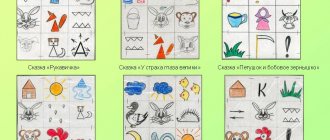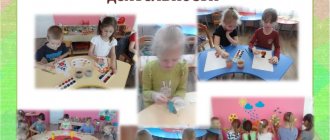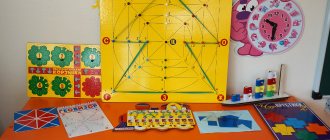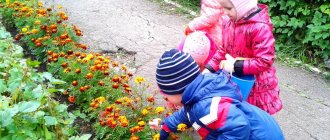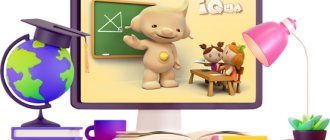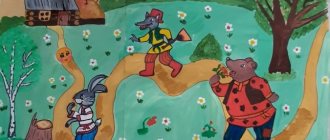The influence of productive activity on the development of a child’s personality
Author: Chernyshova Svetlana Nikolaevna
Municipal autonomous preschool educational institution
"Kindergarten No. 49 "Cheburashka" Malyshevsky urban district
Impact of Productive Activity
on the development of the child's personality
Compiled by: Chernyshova S.N.,
teacher at MADOU
"Kindergarten No. 49 "Cheburashka"
Productive children's activity is the activity of a child with the goal of obtaining a product (construction, drawing, appliqué, molded crafts, etc.) that has certain specified qualities (N.I. Ganoshenko).
Productive types of children's activities include designing, drawing, modeling, appliqué and creating various kinds of crafts and models from natural and waste materials. All these types of children's activities play an important role in the development of a child - a preschooler.
Productive children's activity is formed in preschool age and, along with play, is of greatest importance during this period for the development of the child's psyche, since the need to create a product is closely related to the development of his cognitive processes, emotional and volitional sphere, skills, moral , aesthetic and physical education of preschool children.
These actions develop not only imaginative forms of thinking, but also such qualities as focus, the ability to plan one’s activities, and achieve a certain result.
The social and personal development of a child is facilitated by the opportunity for him to demonstrate creative activity, initiative in creating drawings, modeling, and crafts that he can use himself or show and give to others.
In the process of visual activity and design, children develop the ability for purposeful activity and volitional regulation of behavior.
For the artistic and aesthetic development of a child, the modeling nature of productive activity plays an important role, allowing him to reflect the reality around him at his own discretion and create certain images. And this has a positive effect on the development of imagination, imaginative thinking, and creative activity of the child.
It is important to cultivate in children an aesthetic attitude towards the environment, the ability to see and feel beauty, and develop artistic taste and creative abilities. A preschooler is attracted to everything bright, sounding, and moving. This attraction combines both cognitive interests and an aesthetic attitude towards the object, which is manifested both in evaluative phenomena and in the activities of children.
Productive activity plays a big role in nurturing the aesthetic senses of a preschooler. The specific nature of drawing classes provides ample opportunities for experiencing beauty and for developing children’s emotional and aesthetic attitude to reality. Productive activity shows a person the world of really existing beauty, shapes his beliefs, influences behavior, and promotes the development of children’s creative abilities, which is possible only in the process of preschoolers acquiring and practically applying knowledge, skills and abilities.
Productive activity is closely related to solving problems of moral education. This connection is carried out through the content of children’s work, which reinforces a certain attitude towards the surrounding reality, and through the development in children of observation, activity, independence, the ability to listen and carry out a task, and bring the work started to completion.
In the process of depiction, the attitude towards the depicted is consolidated, since the child experiences the feelings that he experienced when perceiving this phenomenon. Therefore, the content of the work has a great influence on the formation of the child’s personality. Nature provides rich material for aesthetic and ethical experiences: bright combinations of colors, a variety of shapes, the majestic beauty of many phenomena (thunderstorm, sea surf, blizzard, etc.).
When properly organized, productive activities have a positive effect on the child’s physical development, help raise overall vitality, and create a cheerful, cheerful mood. During classes, the correct training posture is developed, since productive activity is almost always associated with a static position and a certain posture. Performing applicative images promotes the development of hand muscles and coordination of movements.
In the process of systematic classes in designing, drawing, modeling, and appliqué, cognitive processes develop:
— Children’s visual representations of surrounding objects are clarified and deepened. A child’s drawing sometimes indicates a child’s misconception about a subject, but it is not always possible to judge from the drawing whether the child’s ideas are correct. The child’s idea is broader and richer than his visual capabilities, since the development of ideas outstrips the development of visual skills.
— In the process of productive activity, the child’s visual memory is actively formed. As is known, developed memory serves as a necessary condition for successful cognition of reality, since thanks to memory processes, memorization, recognition, reproduction of cognizable objects and phenomena, and consolidation of past experience occur. Fine creativity is unthinkable without operating with images of the child’s memory and ideas obtained directly in the process of drawing. The ultimate goal for a preschooler is such knowledge of a subject that would make it possible to master the skill completely freely and depict it according to the idea.
— The development of visual-figurative thinking occurs in the learning process. Research by N.P. Sakulina showed that successful mastery of image techniques and the creation of an expressive image require not only clear ideas about individual objects, but also the establishment of connections between the appearance of an object and its purpose in a number of objects or phenomena. Therefore, before starting the image, children solve mental problems based on the concepts they have formed, and then look for ways to implement this task.
— The fundamental point in design is the analytical and synthetic activity of examining objects. It makes it possible to establish the structure of an object and its parts, and take into account the logic of their connection. Thus, a tower with a too narrow base collapses. Based on analytical-synthetic activity, the child plans the course of construction and creates a plan. The success of the implementation of a plan is largely determined by the preschooler’s ability to plan and control its progress.
— In classes on drawing, modeling, applique and design, children’s speech develops: the names of shapes, colors and their shades, spatial designations are learned, and their vocabulary is enriched. The teacher involves children in explaining tasks and the sequence of their completion. In the process of analyzing the work, at the end of the lesson, children talk about their drawings, modeling, and express judgments about the work of other children.
In the process of systematic design and application classes, children intensively develop sensory and mental abilities. The formation of ideas about objects requires the assimilation of knowledge about their properties and qualities, shape, color, size, position in space.
In the design process, preschoolers acquire special knowledge, skills and abilities. By constructing from building material, they get to know each other
— with geometric volumetric shapes;
- with techniques for modifying flat forms by bending, folding, cutting, gluing paper, resulting in a new three-dimensional form.
When designing from paper, children's knowledge of geometric plane figures, concepts of sides, angles, and center are clarified. Get ideas about the meaning of symmetry, balance, proportions;
In the process of productive activity, such important personality qualities as mental activity, curiosity, independence, initiative, which are the main components of creative activity, are formed. The child learns to be active in observation, doing work, showing independence and initiative in thinking through content, selecting materials, and using a variety of means of artistic expression.
Equally important is the education in the process of productive activity of purposefulness in work, the ability to complete it, accuracy, the ability to work in a team, diligence, and inquisitiveness.
According to teachers and psychologists, a child’s mastery of types of productive activities is an indicator of a high level of his overall development and preparation for school. Productive activities greatly contribute to the mastery of mathematics, work skills, and writing.
The processes of writing and drawing have superficial similarities: in both cases, they are graphic activities with tools that leave marks in the form of lines on paper. This requires a certain position of the body and hands, the skill of holding a pencil and pen correctly. Learning to draw creates the necessary prerequisites for successful mastery of writing.
During productive activities, children learn to use materials carefully, keep them clean and tidy, and use only the necessary materials in a certain sequence. All these points contribute to successful learning activities in all lessons.
Conclusion.
Productive activity is an important means of all-round development of children. Learning to draw, sculpt, appliqué, and design contributes to the mental, moral, aesthetic and physical education of preschool children.
Used Books:
1. Davydova G.N. Unconventional drawing techniques in kindergarten.
2. Davydova G.N. Plasticineography.
3. Doronova T.N. Materials and equipment for productive activities.
4. Dyachenko O.M. Development of a preschooler's imagination. - M.: RAO, 2000.- 197 p.
5. Mukhina BC Visual activity as a form of assimilation of social experience. - M., 2000.
6. Uruntaeva G.A.
Preschool psychology: Textbook. aid for students avg. ped. textbook establishments. 5th ed., stereotype. - M.: Publishing House, 2001. - 336 p. comments powered by HyperComments
What are productive activities?
This is the name for activities as a result of which the child will create a given product with the specified qualities. Which of them are productive activities:
- modeling of figures and applications from plasticine and clay;
- assembling an interesting structure in all possible ways;
- making crafts from various materials (paper, cardboard, beads, foliage and others);
- complex classes with layouts;
- creating pictures with paints, pencils, chalk;
- production of applications and mosaics.
All types of productive activities are important for children's development. Preschoolers need to be interested in order to get the desired result, but this is the work of teachers. All institutions aimed at educating young children include these activities. Parents should know what the productive activity of a preschooler is aimed at and why it is so important. If you teach your child at home on your own or prefer not to send him to kindergarten, then this publication will be useful for you.
Lesson results
It is necessary to create a system of activities for children. If the teacher correctly distributes productive activities, and all its types are involved, the result will be as follows:
- children will be developed creatively;
- the group will have an excellent psychological atmosphere;
- preschoolers will be well prepared for school classes.
Most often, productive activity connects several areas, such as creativity, socialization, cognition, labor, communication, and the safety of preschoolers. Artistic and productive activities and creativity help develop a child’s speech. At this age there are many problems with her, such as poverty (poor vocabulary), monosyllabicity, it consists only of simple sentences, and the words are far from beautiful and literary. For example: “what”, instead of “what”, “beautiful flower”, instead of “I like this flower because...”, but instead of “I don’t want this because...” you can hear “leave me alone”, and others expressions. Children need to be taught to speak beautifully and explain their preferences more fully and efficiently.
In addition, children receive moral education, consolidate the knowledge acquired in the learning process, and develop the necessary character qualities:
- activity;
- independence;
- observation;
- determination;
- patience;
- the desire to finish what you started;
- the ability to “sort out” the information received and assimilate it.
Productive activity also improves the physical condition of children. They become more cheerful, their mood improves, their overall tone increases, their character becomes more relaxed and active. After classes and during them, the child is active. It is important to immediately correctly form his posture, gait, and body position, because all these qualities will be useful to the little man in the future. Productive activity allows you to coordinate movements, “tune” the vestibular apparatus, and strengthen the muscles.
Now we propose to get acquainted with the main types of productive activities. And at the same time we will note the features of each.
